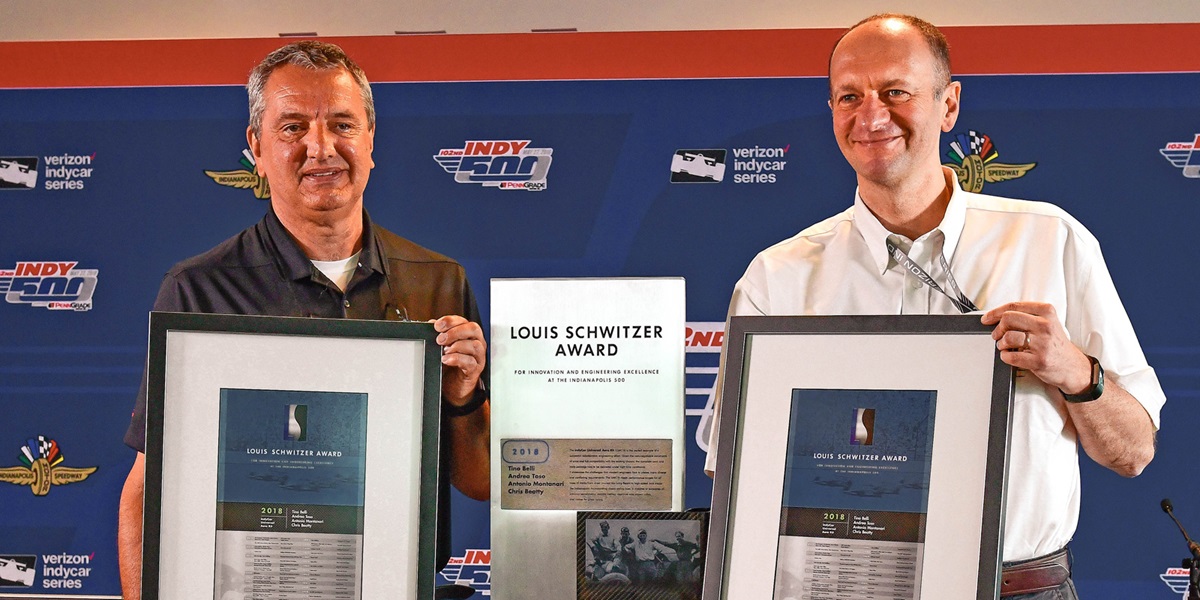
Developers of Sleek, New Universal Aero Kit Honored with Louis Schwitzer Award
May 18, 2018 | By Joey Barnes, INDYCAR
Fans and drivers alike have raved about the 2018 Verizon IndyCar Series car for its sleek look, challenge to drive and added safety enhancements. The engineering world agrees.
The prestigious Louis Schwitzer Award was awarded Friday to four men instrumental in the design and development of the universal aero kit. Tino Belli, INDYCAR’s director of aerodynamic development who spearheaded the program, was honored with the award along with Andrea Toso and Antonio Montanari of Dallara, INDYCAR’s chassis and aero kit manufacturer, and Chris Beatty, whose conceptual aero kit designs were significant every step of the development process.
The Schwitzer Award is presented by BorgWarner and the Indiana Section of the Society of Automotive Engineers. It includes a $10,000 prize, as well as having recipients’ names added to a trophy listing all winners dating to the first presentation in 1967.
The Schwitzer Award recognizes individuals for innovation and engineering excellence in racing technology associated with the Indianapolis 500. It memorializes Louis Schwitzer, winner of the first auto race at IMS in 1909 and designer of the “Marmon Yellow Jacket” engine that powered the Marmon Wasp to victory at the first Indianapolis 500 in 1911.
“You see four people have been awarded (this year), that means a lot,” said Toso, head of research and development and U.S. racing programs for Dallara. “(This) means that it's been a team effort.”
Toso is a three-time Schwitzer Award recipient. He won in 2008 for Dallara’s INDYCAR chassis and again 2014 for its racing simulator.
“This award is for engineers, provided by engineers, so it's just in the technical environment,” Toso said. “I see this award as a right example to reward engineers. The engineers are the unsung heroes of our society. They are under a lot of pressure to comply with a lot of requirements – technical, stylish, performance, crash safety and such. Really, they are on the front stage like we are today.”
Belli, who guided the aero kit development along with Bill Pappas, INDYCAR vice president of competition for race engineering, said it began in 2015. INDYCAR polled teams and sought fan input on how the car should look. The kit’s design was reverse-engineered to look appealing and then build in the necessary performance and safety requirements.
“Chris was doing for us maybe 30 or 40 renderings a day of different configurations,” Belli said of Beatty, who is based in the United Kingdom. “Then, Bill and I were picking the ones which seemed to have the right proportions and then sending those renderings to (the Dallara factory in) Italy in the CAD (computer-aided design) and saying, ‘Hey, we need it like this, so make this part.’”
Belli was also awarded the Schwitzer twice before, in 2010 for his part in developing a radiator and again in 2016 for the rear wing beam flap added to make the cars more stable when they spin.
Belli believes the universal aero kit achieved nearly everything asked of it when INDYCAR went to the drawing board. Not only did it provide a look that has drawn wide praise, it enhanced the on-track product, as well. There have been 1,213 on-track passes made in the first five races of the season, more than double the number at the same point a year ago.
“(I’m) very pleased because it was a very big ask at the beginning,” Belli said. “Certainly, I know that Andrea felt that the targets that we set were probably unachievable, and we thought maybe the targets were unachievable here at Indy.”
The universal aero kit is making its superspeedway version debut at the 102nd Indianapolis 500 presented by PennGrade Motor Oil. Always the engineer, Belli is waiting to give it the final seal of approval until after qualifying this weekend and the race on May 27.
“The actual test is going to be this weekend,” Belli said, “but we felt that, with an abundance of caution this first year, we wanted to target qualifying, if anything, more to the slow side. Get this first year and make sure the car has all the stability that it needs and then next year we might think about pushing the envelope a little bit further.”
In addition to Dallara and Beatty, Belli credited the teams that participated in the kit’s development testing last summer and fall, as well as engine manufacturers Chevrolet and Honda, for doing whatever was asked by INDYCAR as items were refined to come up with a final product. “A very collaborative effort,” Belli said.
Again, always the engineer, Belli is already thinking about the next-generation INDYCAR chassis to replace the Dallara IR-12 in use since 2012. The new chassis won’t debut for at least three years.
“Bill and I have had a lot of talks of how we see the design of the cars going in the future,” said Belli. “But really they're nothing more than just backwards and forwards (discussions).
“In general, we really wanted to get through this month first (with the new kit). It's a very different car to what we've had since 2012. It was very important for us to concentrate on getting through this month.
“I think after this race is through, we might start to think a little bit more about the next generation.”